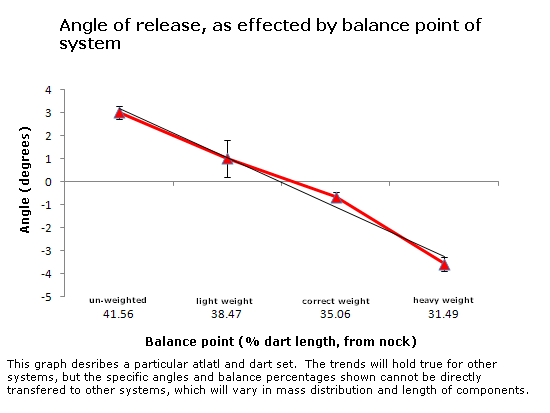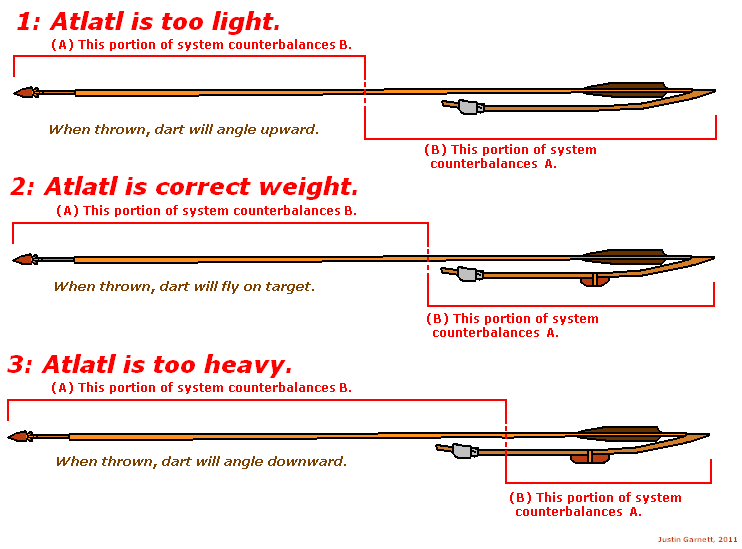Justin Garnett, 2011
General:
There is anecdotal evidence to support the function of stones in adding “power” to atlatls, however when tested the effects of additional weight are deleterious. This is because when the hand grips an atlatl tightly, it is forced to accelerate the mass of the stone in addition to that of the atlatl and dart themselves, which takes additional energy, and therefore robs the projectile of potential momentum.
In contrast to this grip style is what will be termed a “Floating grip” in which the atlatl is but loosely attached to or held in the user’s hand, and the lower handle is either physically absent, or not firmly gripped. In this case, leverage is applied in a final downward snap, the speed of which is largely dependent of the momentum of the cast, rather than by the action of a stiff wrist. This is significant, as the loops in this case serve as a form of “Buffer” in the transaction between hand and atlatl. Although most any atlatl can be thrown with this grip method, certain specimens, for instance “Truncated handle” atlatls (Those lacking handles long enough to be gripped when the fingers are in place in the finger loops) such as Broken Roof Cave or the McClure atlatls, could not have been used any other way.
Adding weights to the atlatl appears to have two effects on atlatls performance, the first “static” (That is, an effect on the system while at rest) and the second dynamic (That is, an effect on the system in motion). The first effect is one of increased handling-the counterbalancing of the weight of the dart. Bringing the balance point of the dart to above or slightly ahead of the user’s wrist improves comfort and stability in use. This improvement in balance and handling can be profound when compared to an atlatl which is either far too heavy or far too light for it’s dart. This static effect is true of any atlatl and dart system, regardless of gripping method.
The second effect is dynamic, and specific to atlatls which are gripped but loosely (in a “floating grip”). When throwing darts with a light atlatl and a “Soft” transition between the hand and lever arm of the atlatl, (i.e. a “Floating” type grip) an effect can be observed wherein the darts leave the atlatl tail-down, as if dramatically overspined. This effect leads to poor performance through diminished accuracy and decreased projectile kinetic energy. These poor flight characteristics are caused by the tendency of the dart to disengage from the atlatl early in the cast. This is essentially an approach toward a “De-hooking” type effect-that is, a premature release of the dart from the atlatl wherein the atlatl swings away and downward from the dart at an early point in the cast, wasting energy which otherwise would have gone to the dart in an exaggerated “Followthough”. These poor flight characteristics appear to be due to the mass of the dart resisting the forward acceleration of the atlatl and tipping the atlatl backward, at the soft transition at the fingerloops.
Adding weight to the atlatl maintains solid dart contact through the cast. When swung, the weight adds a centrifugal outward force on the atlatl, maintaining strong contact with the nock of the dart through the critical release point of the cast. Additionally, this additional centrifugal force aids overcoming of the tendency of the dart’s mass to “Stay at rest” and tip the atlatl (And therefore the dart nock) down in the cast. In effect, the weight helps, through centrifugal effect, to “Stiffen” the soft transition between the hand and the atlatl and dart, allowing the thrower to maintain good dart contact up until the moment of release.
To summarize, two measurable effects can be observed from addition of weights to lightweight atlatls:
- The static effect: Improved handling through optimized balance, that is, a balance point of the atlatl and dart system at or near the user’s hand, and,
- The dynamic effect: Maintaining good spur-nock contact through the cast via a centrifugal stabilizing effect.
Experimental design:
Before conducting this experiment to characterize dart behavior with the grip, a preliminary experiment was performed using a very light atlatl in order to accentuate the difference between weighted and unweighted configurations, and therefore maximize the chances of observing a difference in behavior. The expected difference manifested itself as poor accuracy, balance, and flight characteristics, all of which were corrected by addition of significant weights. The experiments being reported on here were performed with a matched set of atlatl and darts based on the artifacts from White Dog Cave, Arizona. The atlatl handle was cut off below the finger loops, and therefore useless to the throwing motion. All “unweighted configuration” images show a “Tail down” flight of the dart, immediately after disengagement from the atlatl. This tipping begins before the actual moment of release, and the dart remains diagonal, point up, throughout the first 10-12 yards of flight, at which point it’s tip weight corrects the flight somewhat, and at impact the point is angled downward. In contrast is the flight of the weighted configuration, in which the dart leaves the atlatl horizontally and maintains that orientation throughout flight. The weights used were single weights, (to simplify addition and removal during experimentation) placed just distal of the center of the atlatl lever arm, and brought the balance point to just proximal (Relative to the atlatl) of the user’s wrist. Data was collected photographically, by analysis of still frames from videos. The masses of components and their effects on atlatl-dart balance point are noted in tables 1-3.
Tables 1-3.
Discussion of findings:
The effects of atlatl weight mass to the system was, in this experiment, quite profound, and easily measured. The representative photographs below were selected to demonstrate the change in release angle (As nearly as could be photographically approximated with the available cameras). In any case, the angles are valid, as later frames following dart flight show the darts continuing along the trajectory angles established by these photographs. Representative photographs are shown in figure 1.
Fig 1. Un-weighted and “Light” weight configurations show tipping down of dart nock, consistent with behavior of an overspined dart shaft. Conversely, the “Heavy” weight configuration shows dart behavior in line with an underspined shaft. The same dart was used in all scenarios.
When the release angles of three representative throws for each configuration were analyzed, there was great consistency. Graphical representation of this data is shown in figure 2.
Fig. 2.
Atlatl weights serve to balance the atlatl and dart when at rest, and serve to modify release angle of the dart when the atlatl and dart are thrown with a relaxed wrist. If the effect on release angle of the dart were governed solely by at-rest balance of the system, the effect of adding additional mass to the atlatl in a well-balanced system would be to tip back the rear of the dart resulting in a release angle greater than 0. However, what is actually observed was the reverse; adding weight to a well balanced system, while indeed tipping back the rear of the dart at rest, actually served to decrease the angle of release to below 0. This is because centrifugal force generated by the swinging of the weight overcomes the dart’s weight, tipping the dart nock upward in the release. This model can be best summarized in figure 3.
Fig. 3: Model of atlatl weight function in a “truncated handle” or “Floating gripped” configuration.
Obviously these results should be investigated further, but it would appear as though atlatl weights act as counterbalances when at rest, and as profound modifiers of dart spine when in action.





